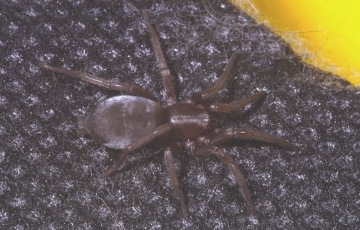Summary for Scotophaeus blackwalli (Araneae)
previous species | next species
National Distribution
Terms of Use. Double-click on map to go to region

Explore Regional Distribution
Please log on and add a note on this species
About this species
Recorded altitude range1m to 400m
Species text
DistributionThe species is widespread in much of England with scattered records in Wales and Scotland as far north as Kincardineshire. It is widespread in north-western and central Europe and the Palaearctic in general.
Habitat and ecology
In Britain S. blackwalli typically seems to be restricted to houses, sheds, etc. which suggests that this species has migrated northwards from warmer places. It has been found in gardens on bushes and can be fairly common on wooden fences and under bark of dead trees in urban situations in Leicestershire (J. Daws, pers. comm.). These outdoor specimens have been noted as generally much larger than those from inside houses (Crocker & Daws 1996). Certainly, in the Mediterranean region, where there are more Scotophaeus species, these are often lighter coloured and are to be found under flakes of bark on trees (particularly pines) and even in the dried stalks of reeds. In Britain one often comes across S. blackwalli at night, creeping stealthily on the walls or ceilings of a house. It may be that S. blackwalli does so, unnoticed, during daylight and that it is its dark colour and sinister movement that catches the eye when the electric light is switched on. Adults have been recorded throughout the year, but mainly in summer.
Status
Relatively common.
Original author of profile: J.A. Murphy
Text based on Harvey, P.R., Nellist, D.R. & Telfer, M.G. (eds) 2002. Provisional atlas of British spiders (Arachnida, Araneae), Volumes 1 & 2. Huntingdon: Biological Records Centre. References
Adult Season
Habitats
background methodology
Recorded management for locations with Scotophaeus blackwalli
Recorded substrate and hydrology for locations with Scotophaeus blackwalli
Images
please log on and upload a new image for this speciesSee also A-Z Species Index - A-Z Picture Index - previous species | next species











